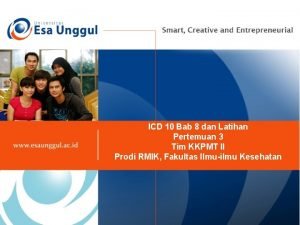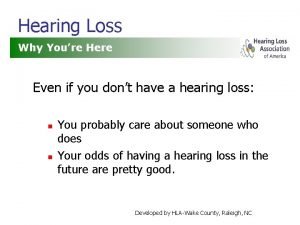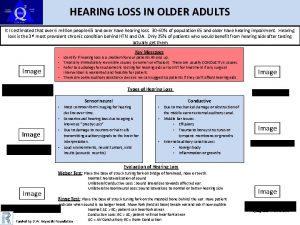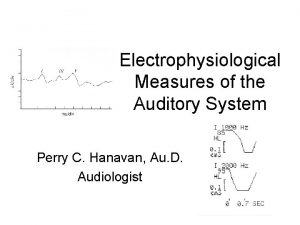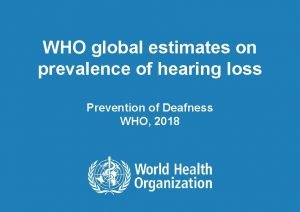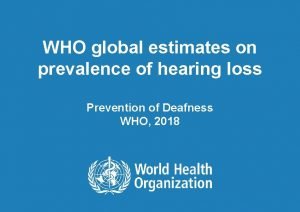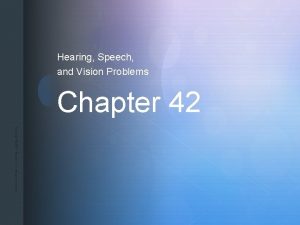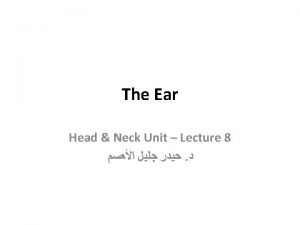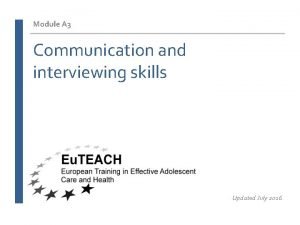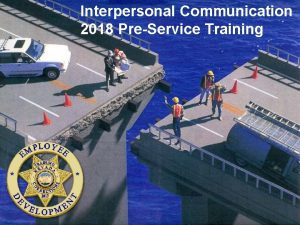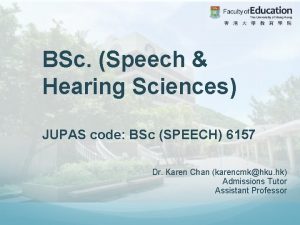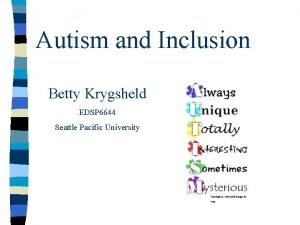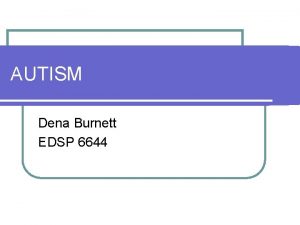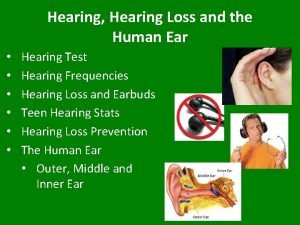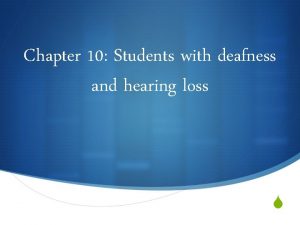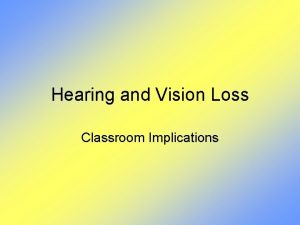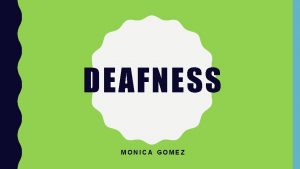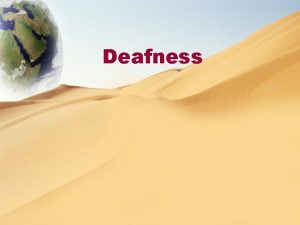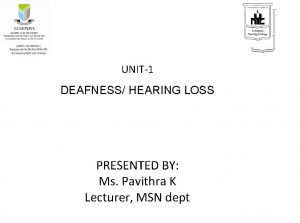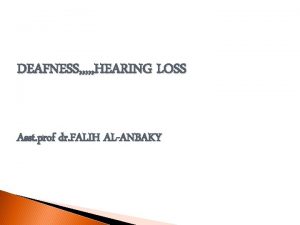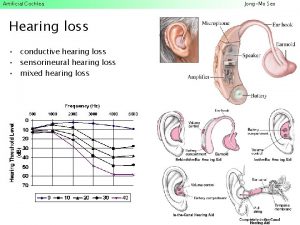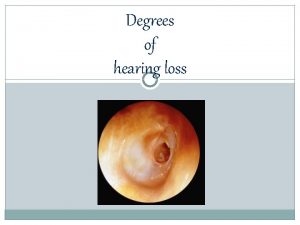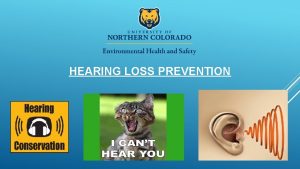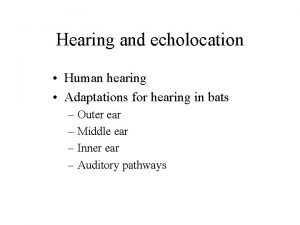Deafness and Hearing Loss Patrick Moriarty EDSP 6644




















- Slides: 20

Deafness and Hearing Loss Patrick Moriarty EDSP 6644

Definition Hearing impairment is when an individual loses the ability to hear in either one or both ears. The level of impairment can vary from mild to severe or total loss of hearing.

IDEA The Individuals with Disabilities Education Act defines deafness and hearing impairment as follows: “Deafness means a hearing impairment that is so severe that the child is impaired in processing linguistic information through hearing, with or without amplification, [and] that adversely affects a child’s educational performance. . Hearing impairment means an impairment in hearing, whether permanent or fluctuating, that adversely affects a child’s education performance but that is not included under the definition of deafness…” (Heward, 2009).

2 Types There are two types of hearing impairment: one is called conductive hearing impairment which is when the outer or middle ear is damaged. This can be medically treated. The second is sensorineural and this is when there is damage to the inner part of the ear. In most cases, this is irreversible and cannot be healed.

Facts • Nearly 300 million people worldwide suffer from some hearing loss in both ears. • The majority of those people live in developing or middle class countries. • About 38 million Americans report some hearing loss. • 2 to 3 out of 1000 children born in the U. S. are born deaf or hard-of-hearing. 9 out of 10 are born to parents with hearing.

Characteristics • Difficulty following directions and instructions • Difficulty with interpersonal skills • Language delay • Easily frustrated leading to behavioral difficulties • They use American sign language as their first language

Characteristics Cont. • Difficulty with speech, reading and writing skills • Often struggle with reading and writing because sign language is their first language, so English is a second language for them • Socially, deaf culture varies. “Big D” deaf people usually only socialize with others who are deaf. “Small d” deaf people try to identify with those who are not deaf. Cochlear implants are accepted by the “small d” deaf community and shunned by the “big D” deaf community.

Causes • Inherited • Premature birth • Certain conditions during birth like lack of oxygen to breath • Conditions during pregnancy such as rubella, syphilis, and other infections • Jaundice and other infectious diseases. • Certain drugs can cause deafness • Head injuries • Excessive loud music • Old age, to name a few

Article Reviews

Hearing Impaired Children’s Retelling Of Stories Following Presentation In Whole. Class And Individual Contexts • This research focused on six students with hearing impairment and their ability to remember a story recited to the class • The goal was to “determine whether the factors of group size and interaction influence their comprehension when stories are read aloud (simultaneous presentation through signing and speaking)” • Four presentation situations were used, and a different book was read in each situation • After a period of time, the students would then retell the story to the teacher Andrews, S. , et al. (1995). Hearing impaired children’s retelling of stories following presentation in whole-class and individual contexts. Retrieved from: http: //www. eric. ed. gov/PDFS/ED 389145. pdf

Findings Results • “When each story element (setting, presteps, problem, attempts, resolution, ending) was examined individually, the group interactive reading condition appeared to be the most effective overall…” • Specifically, for inclusion of setting, the interactive and non-interactive group were equally effective Conclusions • If a teacher is teaching comprehension to the deaf or hearing impaired, he/she is more likely to be successful if it is presented as a group interactive reading presentation • Small group interactions are an effective method of instruction not only for a general education population, but can be successful in self-contained classrooms • And for eliciting resolution, the individual non-interactive group was equally effective. Andrews, S. , et al. (1995). Hearing impaired children’s retelling of stories following presentation in whole-class and individual contexts. Retrieved from: http: //www. eric. ed. gov/PDFS/ED 389145. pdf

Paternal Involvement in the Programs of Hearing-impaired Children: An Exploratory Study • This research looks at the nature of a father’s involvement with his hearing impaired child. It focused on how the father’s involvement differed from the involvement of the child’s mother • There is an emphasis on looking at the “technical” involvement and the “expressive” involvement • 20 sets of parents participated in the study which was exploratory and descriptive. There was a total of 23 hearing impaired children in the study • The parents were asked to answer 10 questions and a 13 -item scale • The questions and scale were answered separately by each parent Mc. Neil, M. & Chabassol, D. J. (1984). Parental involvement in the programs of hearing-impaired children: An exploratory study. The Family with Handicapped Memebers, 33 (1), 119 -125. Retrieved from: http: //www. jstor. org/stable/584596

Results Findings • “Fathers are primarily providers and thus are less involved in the concerns of their hearingimpaired child” • “Fathers are unable to become involved in the concerns of their hearing-impaired child because of occupational commitments” • The results also showed that the majority of fathers and mothers believe that the father receives enough information and training about their child’s condition from the mother • Fathers are defensive about their knowledge and this leads to marital conflict; they do not feel welcomed by professionals; and they are aware of their lack of involvement Conclusions • Fathers are typically uninvolved in the life of their hearing impaired child • The mother and father differ in their involvement • It should not go unnoticed that fathers are involved and concerned with important issues in their child’s life • It should also be noted that only “intact” families were studied, no single parent families were used for the study Mc. Neil, M. & Chabassol, D. J. (1984). Parental involvement in the programs of hearing-impaired children: An exploratory study. The Family with Handicapped Memebers, 33 (1), 119 -125. Retrieved from: http: //www. jstor. org/stable/584596

Parents’ Needs Following Identification of Childhood Hearing Loss • This study sought to determine the necessary support needed for a child with hearing loss. More specifically, it sought to understand which components of support parents believed to be most important for their child • Qualitative research methods were applied • “Parents from four intervention programs in three cities in the province of Ontario, Canada, were invited to participate” • Only students who participated in oral communication programs were included in the study • Interviews were conducted using a question guide • Two primary questions focused on the parents’ needs and the parents’ ideas on what components lacked in a support system Fitzpatrick, E. , Angus, D. , Durieux-Smith, A. , Graham, I. , & Coyle, D. (2008). Parents' Needs Following Identification of Childhood Hearing Loss. American Journal of Audiology, 17(1), 38 -49. doi: 10. 1044/1059 -0889(2008/005)

Results Findings Conclusions • The study was conducted shortly after a new universal screening program was implemented in Canada. • “Population-based newborn hearing screening presents new opportunities for children with hearing loss and their families. However, there is a realization that the success of newborn • 17 interviews took place with a total of 21 adults screening is largely dependent on the implementation of participating adequate support programs for children and families (Hyde, • “The profound effect of a childhood hearing loss on 2005; White, 2003; Yoshinaga-Itano, 2004)” (Fitzpatrick, et al. , 2008) the family was captured in the experiences and • Most parents were satisfied with the services and decisions made by parents in the early stages” professionalism of the program (Fitzpatrick, et al. , 2008) • Newborn hearing screening services are essential for • Many parents wanted “to have some notion of the prognosis for their child with a specific hearing loss…”(Fitzpatrick, et all children after they are born al. , 2008) • Access to audiology and therapy services are • Parents want counseling on information that goes beyond imperative during the initial identification stage, but the clinic providers parents were pleased with the services offered after • No specific model of services was ideal for all families the difficult period • More specific needs of the parents was discovered in this • Parents were pleased with language therapy • All parents were offered social support services, but research the quality varied Fitzpatrick, E. , Angus, D. , Durieux-Smith, A. , Graham, I. , & Coyle, D. (2008). Parents' Needs Following Identification of Childhood Hearing Loss. American Journal of Audiology, 17(1), 38 -49. doi: 10. 1044/1059 -0889(2008/005)

Recommendations • Take an interest in the student/s. -Learn what works best for each individual -Understand what they need to be successful -Familiarize yourself with their IEP • Communication and Language -Talk with the special ed. Teacher -Parents are usually a great resource (Mc. Neil & Chabassol, 1984) -Utilize interpreters when you can -Learn sign language, or at least the basics (Heward, 2009) • Trainings/Education -Attend trainings or classes to learn about hearing impairments (Mc. Neil, M. & Chabassol, D. J. 1984) -Utilize professional development and collaborate with other teachers • Instruction -Modify instruction and use various strategies; i. e. , small group, independent, large group work (Andrews, 1995)

Pros • • • Inclusion Deaf students live in a world that is auditory, so it is beneficial for them to be as much a part of it as possible The student has a right to access all that is offered to the general population Students who can hear will benefit from working and socializing with those who differ from them There is an opportunity to learn the expectations of the hearing world They can provide new perspective on certain lessons • • • Cons The student may require more attention than the general education teacher is able to provide The students needs may not be met It could be difficult for the student socially The teacher may not be informed enough to manage the student effectively Opportunities for direct instruction may be restrictive It can be a difficult learning environment without an interpreter (A FAPE right) Nowell, R. , Innes, J. (1997). Educating children who are deaf and hard of hearing: Inclusion (Report No. E 557). Reston, VA: ERIC Clearinghouse on Disabilities and Gifted Education, Council for Exceptional Children. (ERIC Document Reproduction Service No. ED 414675). Stinson, M. , Anita, S. (1999). Considerations in educating deaf and hard-of-hearing students in inclusive settings. J. Deaf Stud. Deaf Education. 4(3): 163 -175 doi: 10. 1093/deafed/4. 3. 163

Applications • Provide preferential seating for the student – By providing preferential seating to the student, I ensure they have a stronger chance of following instruction – The student will be able to maintain eye contact with me, and if they need to read lips, it will be easier for the student • Modify Instruction – When I show videos, I need to make sure there are subtitles or it is closed captioning – When I use music, provide lyrics for the student – Use visual aids when possible • Utilize available services and resources – By using the available services – such as an interpreter – it allows for a greater chance for the student to be successful

Applications continued • Differentiate Instruction – Using a variety of instructional strategies will benefit the student and inform you of ways in which the student learns more effectively – Using • Communicate – Be in constant communication with special education teacher and cooperating teacher to establish goals – Have open dialogue with parents to discuss their expectations as well as mine – Learn sign language

References Andrews, S. , et al. (1995). Hearing impaired children’s retelling of stories following presentation in whole-class and individual contexts. Retrieved from: http: //www. eric. ed. gov/PDFS/ED 389145. pdf Fitzpatrick, E. , Angus, D. , Durieux-Smith, A. , Graham, I. , & Coyle, D. (2008). Parents' Needs Following Identification of Childhood Hearing Loss. American Journal of Audiology, 17(1), 38 -49. doi: 10. 1044/1059 -0889(2008/005) Grant, W. D. (1981). Racial attitudes of hearing-impaired adolescents. Journal of Black Studies. 12(1), 39 -51. (JSTOR Document Reproduction Service No. 2784148). Heward, W. L. (2009). Exceptional children: an introduction to special education. Upper Saddle River, N. J. : Pearson College Div. Mc. Neil, M. & Chabassol, D. J. (1984). Parental involvement in the programs of hearing impaired children: An exploratory study. The Family with Handicapped Memebers, 33 (1), 119 -125. Retrieved from: http: //www. jstor. org/stable/584596 Nowell, R. , Innes, J. (1997). Educating children who are deaf and hard of hearing: Inclusion (Report No. E 557). Reston, VA: ERIC Clearinghouse on Disabilities and Gifted Education, Council for Exceptional Children. (ERIC Document Reproduction Service No. ED 414675). Stinson, M. , Anita, S. (1999). Considerations in educating deaf and hard-of-hearing students in inclusive settings. J. Deaf Stud. Deaf Education. 4(3): 163 -175 doi: 10. 1093/deafed/4. 3. 163
 Tuli icd 10
Tuli icd 10 Kode icd 10 tuli kongenital
Kode icd 10 tuli kongenital Cookie bite hearing loss
Cookie bite hearing loss Conductive hearing loss lateralization
Conductive hearing loss lateralization Tympanometry types
Tympanometry types Scwabach test
Scwabach test Who global estimates on prevalence of hearing loss 2020
Who global estimates on prevalence of hearing loss 2020 Who global estimates on prevalence of hearing loss 2020
Who global estimates on prevalence of hearing loss 2020 Audiogram interpretation ppt
Audiogram interpretation ppt Joanne moriarty
Joanne moriarty Moriarty weather
Moriarty weather Helen moriarty
Helen moriarty The method of unit costing is adopted by
The method of unit costing is adopted by Chapter 42 hearing speech and vision problems
Chapter 42 hearing speech and vision problems Hearing and equilibrium
Hearing and equilibrium External auditory meatus
External auditory meatus Sight hearing taste smell and touch
Sight hearing taste smell and touch Physical barriers to listening
Physical barriers to listening Difference between hearing and listening
Difference between hearing and listening Hku speech and hearing
Hku speech and hearing Discriminative listening
Discriminative listening

